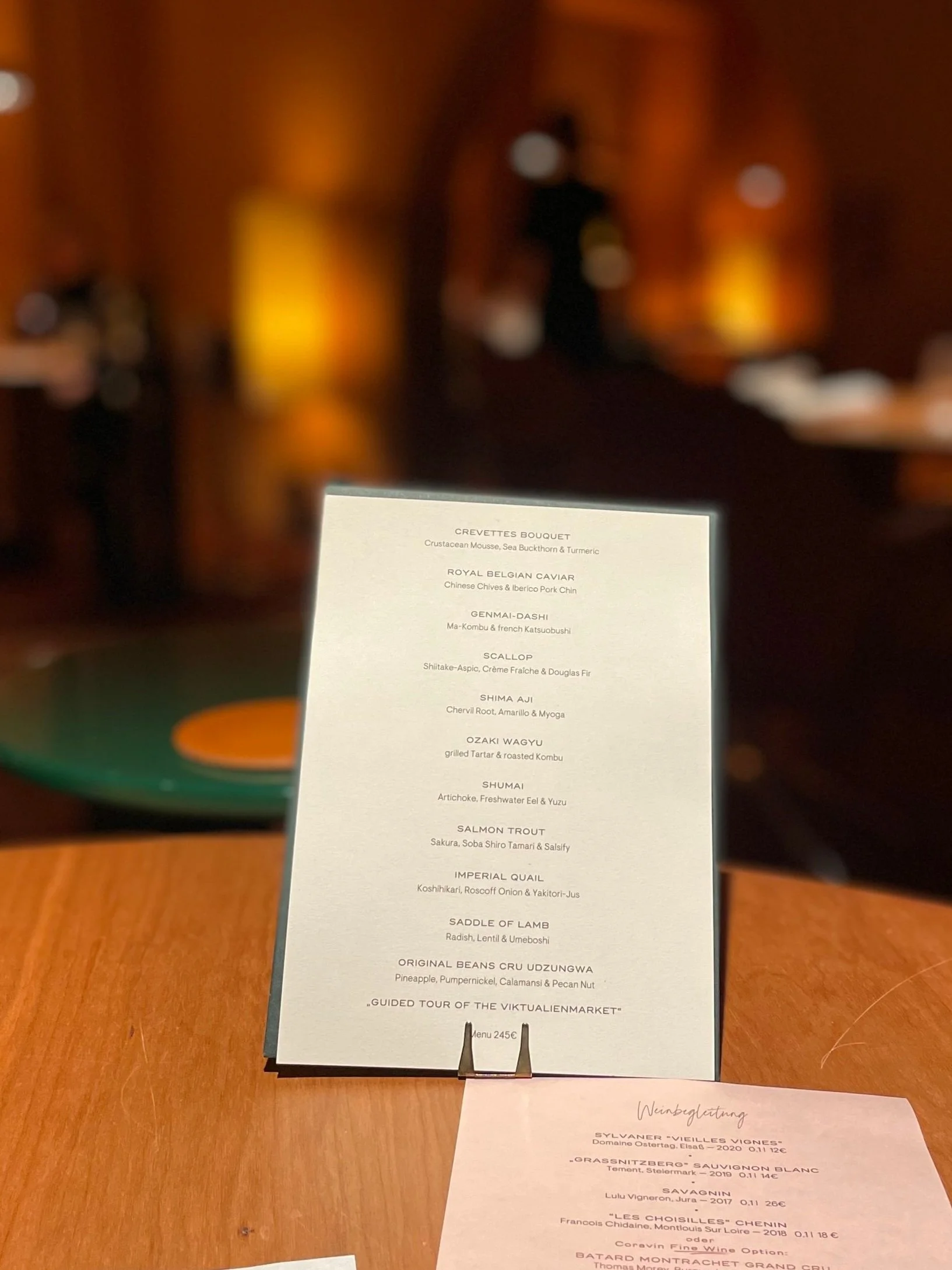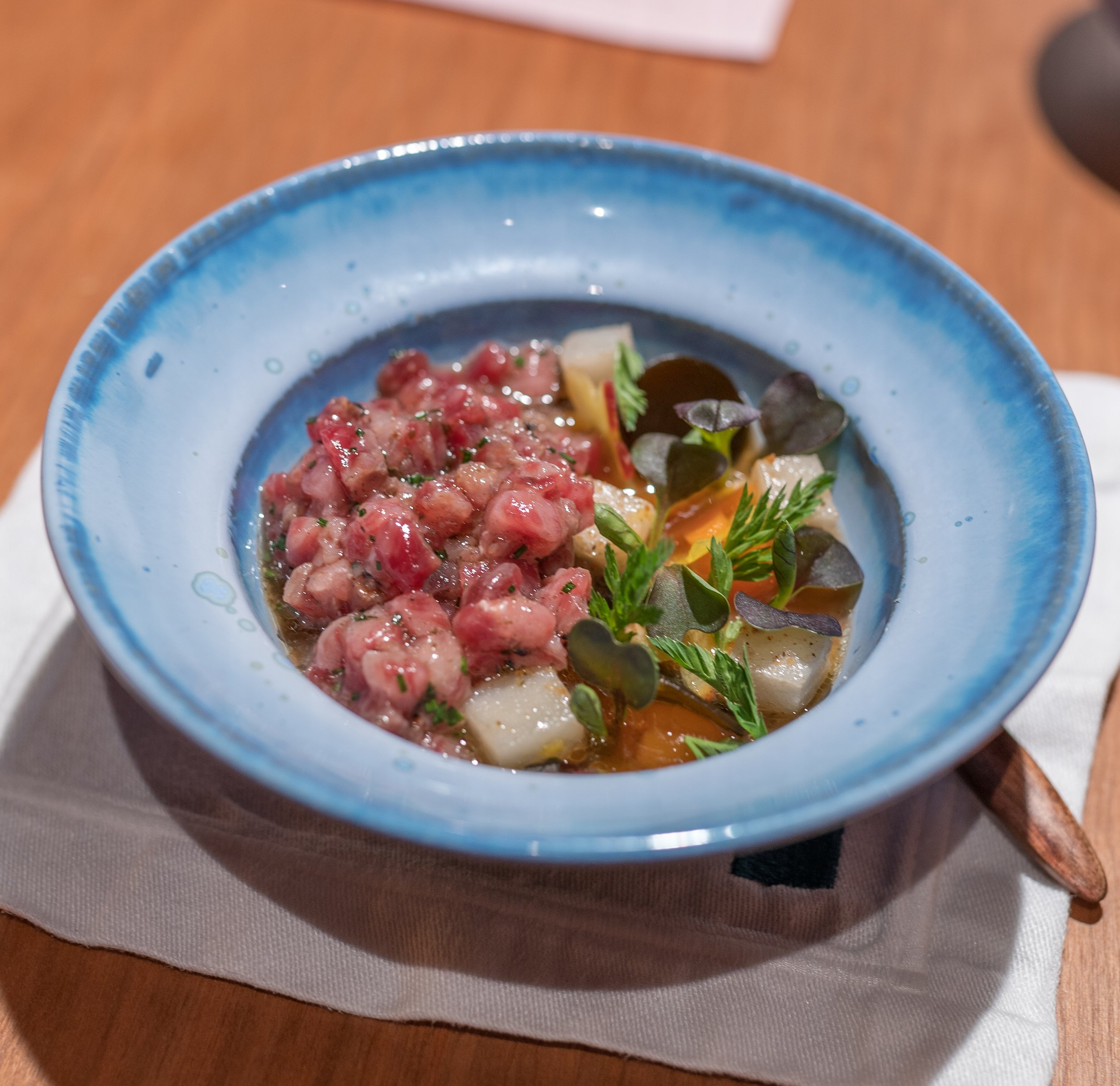Tohru
Tohru review at-a-glance
Rating: 94/100
Verdict: I first tried Chef Tohru Nakamura’s cooking around six years ago when he helmed the kitchen at two star Werneckhof by Geisel. Memories of the meal have faded over time but I remember excellent food, including a standout grilled toro dish, somewhat marred by slow pacing and an overly stuffy atmosphere. While the meal wasn’t perfect, the quality and uniqueness of Tohru’s cooking was enough to entice me to want to revisit him when I heard he opened his own restaurant in Munich.
I am happy to say that the return visit was more than warranted. Tohru’s cooking remains good as ever, an interesting blend of German, Japanese and French influences with great clarity of flavor and consistency throughout a very lengthy menu. Compared to Werneckhof, I found there to be a newfound playfulness to the food and environment that much better reflects Tohru’s personality (or at least my impression of it) and really enhanced the experience. The FOH, run by the twin Klaas brothers, was also a highlight. Beyond keeping the dishes coming at impeccably timed intervals, the entire team was friendly and enthusiastic about the food and wine in a way that went above and beyond the normal trappings of a Michelin restaurant and improved the overall experience.
Price I Paid: €245
Would I revisit: Yes
Date Visited: April 2022
Value: 14/20
Tohru & Chef Tohru Nakamura’s background
Tohru is a restaurant in Munich opened in 2022 by Chef Tohru Nakamuraafter he left his previous restaurant, Werneckhof by Geisel, during the initial wave of COVID lockdowns in March 2020. Between leaving Werneckhof and opening his eponymous restaurant, Chef Nakamura kept himself busy running a “salon rogue” pop-up as well as several other projects. If there were any concerns if Tohru could replicate his success at Werneckhof on his own they were quickly put to bed when his restaurant reclaimed Tohru’s two stars in the first year of opening.
Chef Nakamura’s cuisine reflects his background, a fusion of Japanese (his father) and German (his mothers) influences. I would say things tended towards the Japanese side but there were still plenty of touches that reminded you of Germany like the use of trout and aspic. Tohru’s cooking style is also particularly well suited for tasting menus with tightly designed dishes packing complex flavors in compact packages. Perhaps knowing this, there is no a la carte or menu choice - all guests enjoy the same tasting menu (€245 at the time of my visit).
The wine program is well put together with good depth for a new restaurant. Too often wine pairings don’t list what is included, leaving the guest to wonder if the €100+ investment in the pairing is worth it. At Tohru, sommelier Tobias Klaas does away with this by listing the paired wine for each course and pricing them individually. This lets you drink as much or as little as you want and tailor the wine to your budget - you could skip the more expensive glasses or if looking to splash out opt for some more prestigious glasses poured by the glass via Coravin.
The FOH is capably run by Markus Klaas who incidentally is the sommelier’s twin brother. The resemblance was uncanny and made for quite the sight, giving a bit of deja vu as the twins seamlessly kept the dining room humming smoothly. While the ambiance at Werneckhof was stuffy, the new restaurant is much more relaxed. The lighting is bright with plenty of natural wood and the FOH seems casual but with plenty of attentiveness and passion for the products. Most importantly, the meal moved at a steady pace with dishes coming out at a consistent and appropriate speed which made the lengthy tasting menu fly by.
What I ate at Tohru
Rather than start with small amuse bouches, my meal at Tohru started right away with a dish of crevettes bouquet with crustacean mousse, sea buckthorn & turmeric. This was a really strong start that immediately showed Chef Tohru Nakamara’s ability to blend disapparate global flavors with Japanese techniques. Here, there was a dashi made with crustaceans but also sea buckthorn, a favorite acidic fruit of New Nordic cuisine. The result was a beautifully balanced and delicate sauce that was paired well with the small shrimps from France. This particular type of shrimp lives beneath the mussel farms, eating seaweed that grows on chains around the mussels which gives them an extra sweet flavor. My only complaint is the dish would have benefited from being served on a deeper bowl rather than a flat plate which made it difficult to scoop the sauce on the spoon.
The second course was even better as it featured a Chinese chive and Iberico pork chin dumpling that was topped with top-notch Royal Belgian caviar. The description of this dish sounded great and the flavors did not disappoint. While the dumpling was nice and comforting, Chef Nakamara kept it interesting by pairing it with a sauce made from the fermented rice product typically used to make sake with the saltiness of this sauce pairing very well with the salinity of the caviar. A joyful dish.
The third course is not pictured but showed off a simple cup of genmai-dashi with ma-kombu & french Katsuobushi that had a nice toasted flavor coming through clearly - the type of dish that really warms the soul.
Next up the plates got slightly more substantial with a grilled scallop paired with shiitake-aspic, creme fraiche and douglas fir. The main component of the dish, the scallop, was grilled accurately but not quite as dazzling as the best scallops I have had. It hardly mattered as I loved all the other components of the course so much. Aspic is a popular foodstuff of Bavaria but not exactly a common sight in fine dining so it was quite interesting seeing it used with shiitake. I am no fan of aspic but this worked shockingly well and harmonized wonderfully with the various textures and variations of mushrooms on top of it. The mixture of creme fraiche and Douglas fir was even better, adding a nice tang and woody note to the dish.
Next up was raw shima aji with chervil root, Amarillo & myoga. This was a very nicely composed dish with a tremendous balance of flavors between salty, acidic, and even a tiny bit of heat playing nicely with herbal notes. The shima aji had a firmer texture than I expected (perhaps it was aged?) which I thought worked very well with the other components. As another nice touch, prior to the dish being served, the FOH brought out Tohru’s Japanese book on fish (a gift from his father) to show what shima aji fish looks like.
Previously the restaurant served waygu as the main course but as the conclusion to such a lengthy tasting menu, they found its richness to be overwhelming for guests. To fix this, they decided to serve it earlier as an ever so lightly grilled tartar of Ozaki wagyu with roasted kombu and chawanmushi. Waygu tartar is not a unique idea but the touch of grilling imbued a nice bit of smokiness and I think even improved the texture of the beef, loosening up the intense marbling. Pairing it with a chawanmushi was also very intelligent, the smooth egg custard working in harmony with the tartar. One of the standout dishes of the night.
After the highlight of the tartar, we went back to the seafood with a shumai with artichoke, eel and yuzu. The shuami was filled with an excellent aspic made of tuna (a repeat of the technique used in the first course) but the real highlight was brown butter foam sauce which had a bit of miso to add complexity and make the sauce distinct from the many other brown butter sauces I have had at other restaurants. The eel added another layer of flavor but this dish was really all about the tremendous sauce.
The last seafood dish was salmon trout with sakura, soba shiro, tamari & salsify. The fish was prepared two ways with the main piece cooked lightly in the style of a yakitori on a skewer with the fish left quite rare. Additionally, it was served as tartar which provided a nice juxtaposition on how cooking the fish can change its texture and flavor profile. In my mind, trout can only get so exciting so this was not quite at the level as the other dishes but still a very high standard.
After all the seafood, Tohru proved he was more than capable of cooking meat with a stunning dish of imperial quail with koshihikari rice, roscoff onion & yakitori-jus. Impeccable cook on the bird with the rich jus balanced out by the roscoff onion which tasted about as good as an onion possibly can. The rice was also excellent, adding a good toothsome texture and miles away from the supermarket stuff I am cooking at home.
The high standard continued with a second meat dish focused on saddle of lamb with radish, lentils, & umeboshi. Just like the quail, the protein was immaculately sourced, cooked accurately and paired with a carb that added a nice texture. On the side was Tohru’s “guilty pleasure bread” which the restaurant received par-baked before finishing it by stuffing it with butter, garlic, and other sorts of good stuff. It truly was a guilty pleasure and another playful note for the meal.
The main dessert was Original beans bru Udzungwa with pineapple, pumperknickel, calamansi, & pecan nut. This had interesting textures and flavors but it failed to really strike a chord with me as much as the savory dishes did. Perhaps I just did not get it, but I didn’t really appreciate how the different components (plated in three distinct sections) were supposed to be combined to create a uniform taste.
Better was the petit fours which were presented as a guided tour of the Vikualienmarket with each bite centered around some of the staff’s favorite stands at the famed market. I thought this was a pretty fun way to close the meal and not a gimmick - the bites framed around vendors I have visited in the past actually really reminded me of the essence of those stalls.














